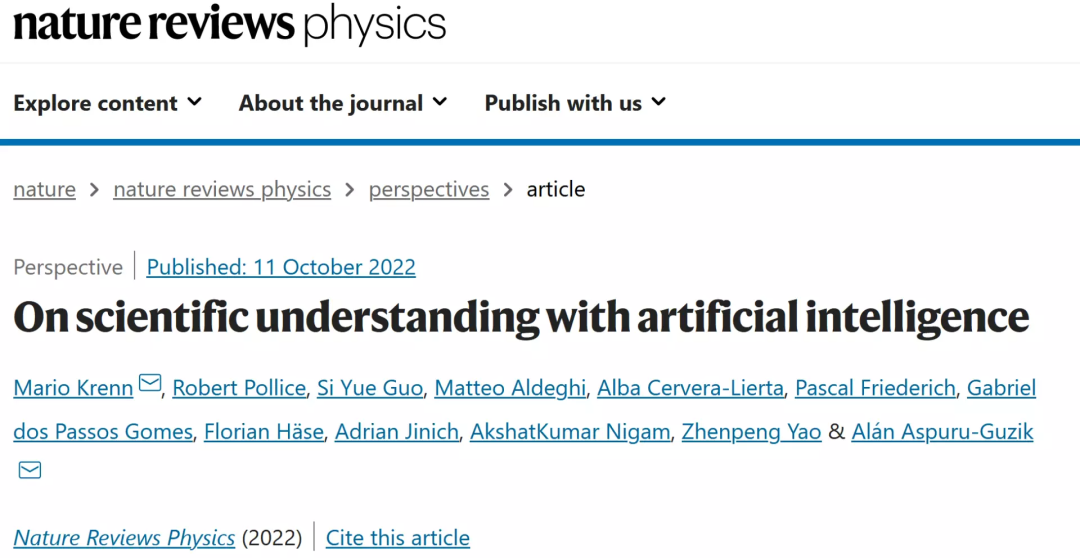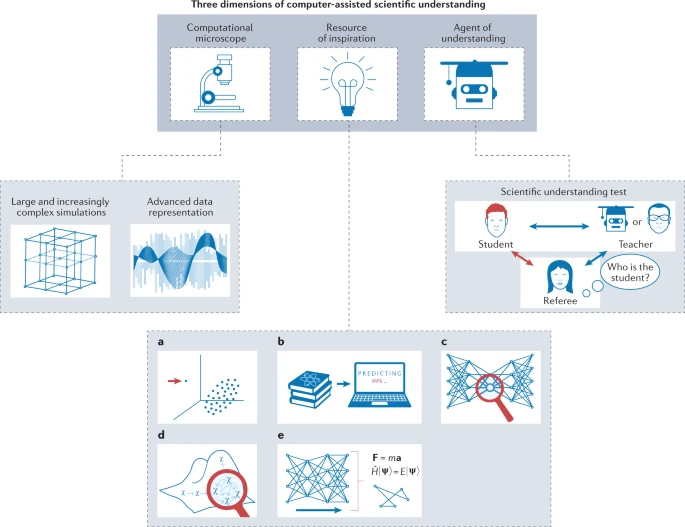一个能正确预测每个粒子物理实验结果、每个可能的化学反应产物或每个蛋白质的功能的先知将彻底改变科学和技术。然而,科学家们不会完全满意,因为他们想了解先知是如何做出这些预测的。这就是科学理解(scientific understanding),科学的主要目标之一。随着可用计算能力的增加和人工智能的进步,一个自然的问题出现了:先进的计算系统,特别是人工智能,如何能够促进新的科学理解或自主地获得科学理解?
为了回答这个问题,我们采用了科学哲学中对“科学理解”的定义,这使我们能够概述关于这个主题的零散文献,并结合科学家的几十个轶事,绘制出计算机辅助科学理解的三个维度。对于每一个维度,我们都回顾了现有的技术状况并讨论了未来的发展。我们希望这个观点能够启发和关注这个多学科的新兴领域的研究方向。
Mario Krenn, Robert Pollice, Si Yue Guo, Matteo Aldeghi等 | 作者
刘志航 | 译者
梁金 | 审校
邓一雪 | 编辑

论文题目:
On scientific understanding with artificial intelligence
1. 引言
2. 科学理解
3. 科学发现与科学理解
4. 计算机辅助理解的三个维度
5. 结语
人工智能(AI)被称为科学的革命性工具,并被预测将在未来的研究中发挥创造性作用。例如,在理论化学的背景下,科学家认为人工智能可以以一种方式帮助解决问题,使得人类无法区分是这种是AI还是与人类专家交流。然而,并非所有科学家都认同人工智能带来的改变。有些人质疑先进的计算方法是否可以超越“数字”,并在根本层面上为获得新的科学理解(scientific understanding)做出贡献。
在本文中,我们将讨论先进的计算系统,尤其是人工智能,如何为科学理解做出贡献:我们概述了目前的可能性以及未来可能出现的情况。除了对文献的回顾,我们还调查了数十名在生物学、化学或物理学交叉领域工作的科学家。这些个人叙述集中于思想的具体发现过程,是对科学文献的重要补充。我们在 Dennis Dieks 和 Henk de Regt 最近提出的科学理解的哲学理论背景下讨论了文献概览和个人叙述。然后,我们确定了人工智能有助于新的科学理解的三个基本层面(图1)。我们将所有先进的人工计算系统都囊括在人工智能这个术语之下,与它们的工作原理无关。这样一来,我们关注的是方法的目标,而不是方法论本身。
首先,人工智能可以作为工具揭示物理系统的属性,然后人类将这些洞察力提升到科学理解。
第二,人工智能可以作为新概念和想法的灵感来源,随后被人类科学家理解和概括。
第三,人工智能可以充当理解的媒介。人工智能达到了新的科学见解,而且重要的是,可以将其理解传递给人类研究人员。尽管还没有任何例子表明人工智能在科学中充当了真正的“理解主体”(agent of understanding),但我们概述了这样一个系统的重要特征,并讨论了实现它的可能途径。
在前两个方面,人工智能使人类获得新的科学理解,而在最后一个方面,机器自己获得理解。对这些类别的区分使我们能够描绘出一个充满活力且大多未被探索的研究领域,并希望能够为自然科学中未来的人工智能发展指引方向。
图1. 计算机辅助科学理解的三个维度。目前最先进的计算显微镜可以用更复杂的系统进一步发展,由于算法和硬件的进步,这些系统可以被模拟,并且有更先进的数据表示(左侧面板)。作为灵感的来源,计算系统可以通过识别数据中的异常(a),识别科学文献中的出乎意料的发现(b),通过检查模型找到意外的概念(c),探索人工主体的行为(d),或者从可解释的解决方案中提取新概念(e)来帮助人类科学家。正文中讨论的科学理解测试在右边的面板上进行了说明。
本文的重点是先进的计算系统和人工智能如何具体促进新的科学理解。有许多相关的、有趣的话题,我们在这里无法涉及。例如,我们将不讨论科学理解与认知科学之间的关系,而是向读者推荐一个很好的概述。此外,我们将只讨论自然科学背景下的“理解”,在自然科学中我们可以使用科学哲学中的具体标准,因此,我们不会触及更广泛背景下的“理解”(比如婴儿和动物的理解,人工智能中的语义理解以及相关话题)。许多其他作品对相关问题有所贡献,在此应该提及。人工智能的一个重要研究领域是可解释人工智能,其目的是解释和说明先进的人工智能算法如何得出它们的解决方案;虽然没有必要,而且我们认为也不足以解释人工智能的内部运作来获得新的科学理解,但许多这些工具和技术可能非常有用。我们将在下面用自然科学中的具体例子来简要解释它们。
人工智能先驱 Donald Michie 将机器学习(ML)分为三类:弱人工智能、强人工智能和超人工智能,其中超人工智能需要机器来教人。超人工智能的机器学习与理解主体的概念有关,我们将在下文中进行定义和详细介绍。一个非常有用的、可理解的科学计算和人工智能方法的集合可以在参考文献中找到。参考文献中描述了分子设计的不同自动化水平,最后一步是由计算机来选择最初的想法。其他作品研究了基于特定科学方法的完全自动化可能是什么样子,从而产生了“诺贝尔图灵挑战”的想法,即开发一个能够做出诺贝尔奖级别科学发现的人工智能系统。我们注意到,我们的观点有目的地不依赖于任何特定的科学方法(以避免基础层面的问题)。相反,我们专注于科学家如何获得“科学理解”,以及先进的人工智能如何帮助人类获得新的科学理解。
先进的计算方法,特别是人工智能的计算方法,将进一步革新科学家研究我们世界的秘密的方式。我们概述了这些新方法如何能够直接有助于获得新的科学理解。我们猜想,未来在使用人工智能获得科学理解方面的重大进展将需要自然科学家、计算机科学家和科学哲学家之间的多学科合作。因此,我们坚信,这些研究工作可以——在我们的有生之年——将人工智能转变为真正的理解媒介,直接促进科学的主要目标之一,即科学理解。
1. Zdeborová, L. New tool in the box. Nat. Phys.13, 420–421 (2017).
2. Fösel, T., Tighineanu, P., Weiss, T. & Marquardt, F. Reinforcement learning with neural networks for quantum feedback. Phys. Rev. X8, 031084 (2018).
3. Melnikov, A. A. et al. Active learning machine learns to create new quantum experiments. Proc. Natl Acad. Sci. USA115, 1221–1226 (2018).
4. Aspuru-Guzik, A., Lindh, R. & Reiher, M. The matter simulation (r)evolution. ACS Cent. Sci.4, 144–152 (2018).
5. Hoffmann, R. & Malrieu, J.-P. Simulation vs. understanding: a tension, in quantum chemistry and beyond. Part A. Stage setting. Angew. Chem.132, 12690–12710 (2020).
6. Hoffmann, R. & Malrieu, J.-P. Simulation vs. understanding: a tension, in quantum chemistry and beyond. Part B. The march of simulation, for better or worse. Angew. Chem. Int. Ed.59, 13156–13178 (2020).
7. Hoffmann, R. & Malrieu, J.-P. Simulation vs. understanding: a tension, in quantum chemistry and beyond. Part C. Toward consilience. Angew. Chem. Int. Ed.59, 13694–13710 (2020).
8. Marcus, G. The next decade in AI: four steps towards robust artificial intelligence. Preprint at arXiv 2002.06177 (2020).
9. Thaler, J. Designing an AI physicist. CERN Courier, https://cerncourier.com/a/designing-an-ai-physicist/ (2021).
10. Potochnik, A. The diverse aims of science. Stud. Hist. Philos. Sci. A53, 71–80 (2015).
11. Potochnik, A. Idealization and the Aims of Science (Univ. Chicago Press, 2017).
12. de Regt, H. W. Understanding Scientific Understanding (Oxford Univ. Press, 2017).
13. De Regt, H. W. & Dieks, D. A contextual approach to scientific understanding. Synthese144, 137–170 (2005).
14. Boden, M. A. Mind as Machine: A History of Cognitive Science (Oxford Univ. Press, 2008).
15. Doran, D., Schulz, S. & Besold, T. R. What does explainable AI really mean? A new conceptualization of perspectives. Preprint at arXiv 1710.00794 (2017).
16. Tjoa, E. & Guan, C. A survey on explainable artificial intelligence (XAI): toward medical XAI. IEEE Trans. Neural Netw. Learn. Syst.32, 4793–4813 (2020).
17. Burkart, N. & Huber, M. F. A survey on the explainability of supervised machine learning. J. Artif. Intell. Res.70, 245–317 (2021).
18. Samek, W., Montavon, G., Vedaldi, A., Hansen, L. K. & Müller, K.-R. Explainable AI: Interpreting, Explaining and Visualizing Deep Learning (Springer, 2019).
19. Michie, D. in Proc. 3rd European Conference on European Working Session on Learning, 107–122 (ACM, 1988).
20. Lavin, A. et al. Simulation intelligence: Towards a new generation of scientific methods. Preprint at arXiv 2112.03235 (2021).
21. Goldman, B., Kearnes, S., Kramer, T., Riley, P. & Walters, W. P. Defining levels of automated chemical design. J. Med. Chem.65, 7073–7087 (2022).
22. Kitano, H. Nobel Turing Challenge: creating the engine for scientific discovery. NPJ Syst. Biol. Appl.7, 29 (2021).
23. Feyerabend, P. Against Method (Verso, 1993).
24. De Regt, H. W. Understanding, values, and the aims of science. Philos. Sci.87, 921–932 (2020).
25. Hempel, C. G. Aspects of Scientific Explanation (Free Press, 1965).
26. Schrödinger, E. ‘Nature and the Greeks’ and ‘Science and Humanism’ (Cambridge Univ. Press, 1996).
27. De Regt, H. W. Visualization as a tool for understanding. Perspect. Sci.22, 377–396 (2014).
28. Friedman, M. Explanation and scientific understanding. J. Philos.71, 5–19 (1974).
29. Kitcher, P. Explanatory unification. Philos. Sci.48, 507–531 (1981).
30. Heisenberg, W. Über den anschaulichen Inhalt der quantentheoretischen Kinematik und Mechanik. Z. Phys.43, 172–198 (1927).
31. Gómez-Bombarelli, R. et al. Design of efficient molecular organic light-emitting diodes by a high-throughput virtual screening and experimental approach. Nat. Mater.15, 1120–1127 (2016).
32. Jumper, J. et al. Highly accurate protein structure prediction with AlphaFold. Nature596, 583–589 (2021).
33. Tunyasuvunakool, K. et al. Highly accurate protein structure prediction for the human proteome. Nature596, 590–596 (2021).
34. Iten, R., Metger, T., Wilming, H., Del Rio, L. & Renner, R. Discovering physical concepts with neural networks. Phys. Rev. Lett.124, 010508 (2020).
35. Seif, A., Hafezi, M. & Jarzynski, C. Machine learning the thermodynamic arrow of time. Nat. Phys.17, 105–113 (2021).
36. Udrescu, S.-M. & Tegmark, M. AI Feynman: A physics-inspired method for symbolic regression. Sci. Adv.6, eaay2631 (2020).
37. Lemos, P., Jeffrey, N., Cranmer, M., Ho, S. & Battaglia, P. Rediscovering orbital mechanics with machine learning. Preprint at arXiv 2202.02306 (2022).
38. Casalino, L. et al. Beyond shielding: the roles of glycans in the SARS-CoV-2 spike protein. ACS Cent. Sci.6, 1722–1734 (2020).
39. Fogarty, C. A., Harbison, A. M., Dugdale, A. R. & Fadda, E. How and why plants and human n-glycans are different: Insight from molecular dynamics into the “glycoblocks” architecture of complex carbohydrates. Beilstein J. Org. Chem.16, 2046–2056 (2020).
40. Friederich, P., Häse, F., Proppe, J. & Aspuru-Guzik, A. Machine-learned potentials for next-generation matter simulations. Nat. Mater.20, 750–761 (2021).
41. Gigan, S., Krzakala, F., Daudet, L. & Carron, I. Artificial intelligence: from electronics to optics. Photoniques104, 49–52 (2020).
42. Xu, X. et al. 11 TOPS photonic convolutional accelerator for optical neural networks. Nature589, 44–51 (2021).
43. Quantum, G. A. et al. Hartree-Fock on a superconducting qubit quantum computer. Science369, 1084–1089 (2020).
44. Zhang, J. et al. Observation of a discrete time crystal. Nature543, 217–220 (2017).
45. Schweizer, C. et al. Floquet approach to Z2 lattice gauge theories with ultracold atoms in optical lattices. Nat. Phys.15, 1168–1173 (2019).
46. Martinez, E. A. et al. Real-time dynamics of lattice gauge theories with a few-qubit quantum computer. Nature534, 516–519 (2016).
47. Cao, Y. et al. Quantum chemistry in the age of quantum computing. Chem. Rev.119, 10856–10915 (2019).
48. Gross, C. & Bloch, I. Quantum simulations with ultracold atoms in optical lattices. Science357, 995–1001 (2017).
49. O’Connor, M. et al. Sampling molecular conformations and dynamics in a multiuser virtual reality framework. Sci. Adv.4, eaat2731 (2018).
50. Probst, D. & Reymond, J.-L. Exploring DrugBank in virtual reality chemical space. J. Chem. Inf. Model.58, 1731–1735 (2018).
51. Schmid, J. R., Ernst, M. J. & Thiele, G. Structural chemistry 2.0: combining augmented reality and 3D online models. J. Chem. Educ.97, 4515–4519 (2020).
52. Foley, M. et al. A 3D view of Orion: I. Barnard’s Loop. Authorea. https://doi.org/10.22541/au.165540488.82174026/v1 (2022).
53. Hill, E., Cherston, J., Goldfarb, S. & Paradiso, J. A. in Proc. 38th International Conference on High Energy Physics, 1042 (2016).
54. Zanella, A. et al. Sonification and sound design for astronomy research, education and public engagement. Nat. Astron.https://doi.org/10.1038/s41550-022-01721-z (2022).
55. Turing, A. M. Computing machinery and intelligence. Mind50, 433–460 (1950).
56. Lehman, J. et al. The surprising creativity of digital evolution: a collection of anecdotes from the evolutionary computation and artificial life research communities. Artif. Life26, 274–306 (2020).
57. Pickard, C. J. & Needs, R. Ab initio random structure searching. J. Phys. Condens. Matter23, 053201 (2011).
58. Krenn, M., Malik, M., Fickler, R., Lapkiewicz, R. & Zeilinger, A. Automated search for new quantum experiments. Phys. Rev. Lett.116, 090405 (2016).
59. Krenn, M., Erhard, M. & Zeilinger, A. Computer-inspired quantum experiments. Nat. Rev. Phys.2, 649–661 (2020).
60. Pickard, C. J. & Needs, R. Highly compressed ammonia forms an ionic crystal. Nat. Mater.7, 775–779 (2008).
61. Krenn, M., Hochrainer, A., Lahiri, M. & Zeilinger, A. Entanglement by path identity. Phys. Rev. Lett.118, 080401 (2017).
62. Krenn, M., Gu, X. & Zeilinger, A. Quantum experiments and graphs: multiparty states as coherent superpositions of perfect matchings. Phys. Rev. Lett.119, 240403 (2017).
63. Krenn, M., Kottmann, J., Tischler, N. & Aspuru-Guzik, A. Conceptual understanding through efficient automated design of quantum optical experiments. Phys. Rev. X11, 031044 (2021).
64. Malhotra, P., Vig, L., Shroff, G. & Agarwal, P. in Proc. European Symposium on Artificial Neural Networks (ESANN), 89–94 (2015).
65. Collaboration, A. Dijet resonance search with weak supervision using s√=13TeV pp collisions in the ATLAS detector. Phys. Rev. Lett.125, 131801 (2020).
66. Collaboration, C. Probing effective field theory operators in the associated production of top quarks with a Z boson in multilepton final states at s√=13TeV. J. High Energy Phys.2021, 83 (2021).
67. Park, S. E., Rankin, D., Udrescu, S.-M., Yunus, M. & Harris, P. Quasi anomalous knowledge: searching for new physics with embedded knowledge. J. High Energy Phys.2021, 30 (2021).
68. Karagiorgi, G., Kasieczka, G., Kravitz, S., Nachman, B. & Shih, D. Machine learning in the search for new fundamental physics. Nat. Rev. Phys.4, 399–412 (2022).
69. Schwartz, M. D. Modern machine learning and particle physics. Preprint at arXiv 2103.12226 (2021).
70. Kasieczka, G. et al. The LHC Olympics 2020: a community challenge for anomaly detection in high energy physics. Rep. Prog. Phys.84, 124201 (2021).
71. Dawid, A., Huembeli, P., Tomza, M., Lewenstein, M. & Dauphin, A. Hessian-based toolbox for reliable and interpretable machine learning in physics. Mach. Learn. Sci. Technol.3, 015002 (2021).
72. Koh, P. W. & Liang, P. in Proc. 34th International Conference on Machine Learning, 1885–1894 (PMLR, 2017).
73. Yu, H., Mineyev, I. & Varshney, L. R. A group-theoretic approach to computational abstraction: Symmetry-driven hierarchical clustering. Preprint at arXiv 1807.11167 (2018).
74. Dehmamy, N., Walters, R., Liu, Y., Wang, D. & Yu, R. Automatic symmetry discovery with lie algebra convolutional network. Adv. Neural Inf. Process. Syst.34, 2503–2515 (2021).
75. Nigam, A. et al. Assigning confidence to molecular property prediction. Expert Opin. Drug Discov.16, 1009–1023 (2021).
76. Davies, A. et al. Advancing mathematics by guiding human intuition with AI. Nature 600, 70–74 (2021).
77. Douglas, M. R. Machine learning as a tool in theoretical science. Nat. Rev. Phys.4, 145–146 (2022).
78. King, R. D. et al. The automation of science. Science324, 85–89 (2009).
79. Bédard, A.-C. et al. Reconfigurable system for automated optimization of diverse chemical reactions. Science361, 1220–1225 (2018).
80. Steiner, S. et al. Organic synthesis in a modular robotic system driven by a chemical programming language. Science363, eaav2211 (2019).
81. Coley, C. W. A robotic platform for flow synthesis of organic compounds informed by AI planning. Science365, eaax1566 (2019).
82. Burger, B. et al. A mobile robotic chemist. Nature583, 237–241 (2020).
83. Chatterjee, S., Guidi, M., Seeberger, P. H. & Gilmore, K. Automated radial synthesis of organic molecules. Nature579, 379–384 (2020).
84. Grizou, J., Points, L. J., Sharma, A. & Cronin, L. A curious formulation robot enables the discovery of a novel protocell behavior. Sci. Adv.6, eaay4237 (2020).
85. Moon, H. et al. Machine learning enables completely automatic tuning of a quantum device faster than human experts. Nat. Commun.11, 4161 (2020).
86. Dalgaard, M., Motzoi, F., Sørensen, J. J. & Sherson, J. Global optimization of quantum dynamics with AlphaZero deep exploration. NPJ Quantum Inf.6, 6 (2020).
87. Larsen, P. & Von Ins, M. The rate of growth in scientific publication and the decline in coverage provided by Science Citation Index. Scientometrics84, 575–603 (2010).
88. Reisz, N. et al. Loss of sustainability in scientific work. New J. Phys.24, 053041 (2022).
89. Evans, J. A. & Foster, J. G. Metaknowledge. Science331, 721–725 (2011).
90. Clauset, A., Larremore, D. B. & Sinatra, R. Data-driven predictions in the science of science. Science355, 477–480 (2017).
91. Fortunato, S. et al. Science of science. Science359, eaao0185 (2018).
92. Wang, D. & Barabási, A.-L. The Science of Science (Cambridge Univ. Press, 2021).
93. Tshitoyan, V. et al. Unsupervised word embeddings capture latent knowledge from materials science literature. Nature571, 95–98 (2019).
94. Olivetti, E. A. et al. Data-driven materials research enabled by natural language processing and information extraction. Appl. Phys. Rev.7, 041317 (2020).
95. Schwalbe-Koda, D., Jensen, Z., Olivetti, E. & Gómez-Bombarelli, R. Graph similarity drives zeolite diffusionless transformations and intergrowth. Nat. Mater.18, 1177–1181 (2019).
96. Rzhetsky, A., Foster, J. G., Foster, I. T. & Evans, J. A. Choosing experiments to accelerate collective discovery. Proc. Natl Acad. Sci. USA112, 14569–14574 (2015).
97. Krenn, M. & Zeilinger, A. Predicting research trends with semantic and neural networks with an application in quantum physics. Proc. Natl Acad. Sci. USA117, 1910–1916 (2020).
98. Devlin, J., Chang, M.-W., Lee, K. & Toutanova, K. Bert: Pre-training of deep bidirectional transformers for language understanding. Preprint at arXiv 1810.04805 (2018).
99. Brown, T. B. et al. Language models are few-shot learners. Preprint at arXiv 2005.14165 (2020).
100. Hamilton, W. L., Ying, R. & Leskovec, J. in Proc. 31st International Conference on Neural Information Processing Systems (NIPS 2017), 1025–1035 (2017).
101. Montavon, G., Samek, W. & Müller, K.-R. Methods for interpreting and understanding deep neural networks. Digit. Signal Process.73, 1–15 (2018).
102. Roscher, R., Bohn, B., Duarte, M. F. & Garcke, J. Explainable machine learning for scientific insights and discoveries. IEEE Access8, 42200–42216 (2020).
103. Lundberg, S. M. et al. From local explanations to global understanding with explainable AI for trees. Nat. Mach. Intell.2, 56–67 (2020).
104. Mahendran, A. & Vedaldi, A. in Proc. IEEE Conference on Computer Vision and Pattern Recognition, 5188–5196 (2015).
105. Mordvintsev, A., Olah, C. & Tyka, M. Inceptionism: going deeper into neural networks. https://ai.googleblog.com/2015/06/inceptionism-going-deeper-into-neural.html (2015).
106. Shen, C., Krenn, M., Eppel, S. & Aspuru-Guzik, A. Deep molecular dreaming: Inverse machine learning for de-novo molecular design and interpretability with surjective representations. Mach. Learn. Sci. Technol.2, 03LT02 (2021).
107. Burgess, C. P. et al. Understanding disentangling in β-VAE. Preprint at arXiv 1804.03599 (2018).
108. Wetzel, S. J. & Scherzer, M. Machine learning of explicit order parameters: From the Ising model to SU (2) lattice gauge theory. Phys. Rev. B96, 184410 (2017).
109. Wetzel, S. J., Melko, R. G., Scott, J., Panju, M. & Ganesh, V. Discovering symmetry invariants and conserved quantities by interpreting siamese neural networks. Phys. Rev. Res.2, 033499 (2020).
110. Friederich, P., Krenn, M., Tamblyn, I. & Aspuru-Guzik, A. Scientific intuition inspired by machine learning-generated hypotheses. Mach. Learn. Sci. Technol.2, 025027 (2021).
111. Flam-Shepherd, D. et al. Learning interpretable representations of entanglement in quantum optics experiments using deep generative models. Nat. Mach. Intell.4, 544–554 (2022).
112. Wellawatte, G. P., Seshadri, A. & White, A. D. Model agnostic generation of counterfactual explanations for molecules. Chem. Sci.13, 3697–3705 (2022).
113. McGrath, T. et al. Acquisition of chess knowledge in AlphaZero. Preprint at arXiv 2111.09259 (2021).
114. Schmidt, M. & Lipson, H. Distilling free-form natural laws from experimental data. Science324, 81–85 (2009).
115. Gentile, A. A. et al. Learning models of quantum systems from experiments. Nat. Phys.17, 837–843 (2021).
116. Cranmer, M. et al. Discovering symbolic models from deep learning with inductive biases. In 34th Conference on Neural Information Processing Systems (NeurIPS 2020) (NeurIPS, 2020).
117. Georgescu, I. How machines could teach physicists new scientific concepts. Nat. Rev. Phys.https://doi.org/10.1038/s42254-022-00497-5 (2022).
118. Cranmer, K., Brehmer, J. & Louppe, G. The frontier of simulation-based inference. Proc. Natl Acad. Sci. USA117, 30055–30062 (2020).
119. Raayoni, G. et al. Generating conjectures on fundamental constants with the Ramanujan Machine. Nature590, 67–73 (2021).
120. Wagner, A. Z. Constructions in combinatorics via neural networks. Preprint at arXiv 2104.14516 (2021).
121. Rahwan, I. et al. Machine behaviour. Nature568, 477–486 (2019).
122. Schmidhuber, J. in Workshop on Anticipatory Behavior in Adaptive Learning Systems, 48–76 (Springer, 2008).
123. Pathak, D., Agrawal, P., Efros, A. A. & Darrell, T. in Proc. 34th International Conference on Machine Learning, 2778–2787 (PMLR, 2017).
124. Thiede, L. A., Krenn, M., Nigam, A. & Aspuru-Guzik, A. Curiosity in exploring chemical spaces: intrinsic rewards for molecular reinforcement learning. Mach. Learn. Sci. Technol.3, 035008 (2022).
125. Varshney, L. R., Rajani, N. F. & Socher, R. Explaining creative artifacts. Preprint at arXiv 2010.07126 (2020).
126. Varshney, L. R. et al. A big data approach to computational creativity: The curious case of Chef Watson. IBM J. Res. Dev.63, 7:1–7:18 (2019).
127. Itti, L. & Baldi, P. Bayesian surprise attracts human attention. Vision Res.49, 1295–1306 (2009).
128. Schmid, U., Zeller, C., Besold, T., Tamaddoni-Nezhad, A. & Muggleton, S. in Proc. International Conference on Inductive Logic Programming, 52–67 (Springer, 2016).
129. Muggleton, S. H., Schmid, U., Zeller, C., Tamaddoni-Nezhad, A. & Besold, T. Ultra-strong machine learning: comprehensibility of programs learned with ILP. Mach. Learn.107, 1119–1140 (2018).
130. Feigenbaum, E. A. Some challenges and grand challenges for computational intelligence. J. ACM50, 32–40 (2003).
131. de Regt, H. W. & Gijsbers, V. in Explaining Understanding: New Perspectives from Epistemology and Philosophy of Science (eds Grimm, S. R., Baumberger, C. & Ammon, S.) 50–75 (2017).
内容中包含的图片若涉及版权问题,请及时与我们联系删除





评论
沙发等你来抢